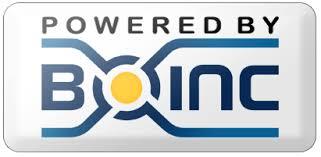BOINC! Computing
Running a very small web server on the Internet means that it is sitting idle for most of the time. This is true of most computers whether they are running continuously or doing normal chores like browsing websites or reading emails.
It can either be accepted that most of the computing power available in a modern computer is unused, or find a way to use that spare computing power can be put to good use. The University of California, Berkley decided to go down the latter path and attempt to harness the millions of personal computers around the world. If they could, they would be able to put together the equivalent of a supercomputer.
From this concept BOINC (Berkley Open Infrastructure for Network Computing) was born. A great name, but did the acronym just occur by happenstance, or was the name designed to get a punchy acronym? The latter, from what I understand.
Anyway, that doesn't really matter. What matters is that the average citizen can help support research that is a bit "out there" like the SETI (Search for Extra-Terrestrial Intelligence) or research that seeks to improve the quality of life for children, such as the World Community Grid which has projects like "Mapping Cancer Markers" and "Smash Childhood Cancer". While SETI@home is no longer running, there are still lots of opportunities to support research.
BOINC also spawned a whole series of support functions that are unrelated to the actual scientific computing, allowing volunteer computers to monitor how these tasks are progressing and how their system rate against systems of other volunteers. Not only that, volunteers can band together in teams.
It can either be accepted that most of the computing power available in a modern computer is unused, or find a way to use that spare computing power can be put to good use. The University of California, Berkley decided to go down the latter path and attempt to harness the millions of personal computers around the world. If they could, they would be able to put together the equivalent of a supercomputer.
From this concept BOINC (Berkley Open Infrastructure for Network Computing) was born. A great name, but did the acronym just occur by happenstance, or was the name designed to get a punchy acronym? The latter, from what I understand.
Anyway, that doesn't really matter. What matters is that the average citizen can help support research that is a bit "out there" like the SETI (Search for Extra-Terrestrial Intelligence) or research that seeks to improve the quality of life for children, such as the World Community Grid which has projects like "Mapping Cancer Markers" and "Smash Childhood Cancer". While SETI@home is no longer running, there are still lots of opportunities to support research.
BOINC also spawned a whole series of support functions that are unrelated to the actual scientific computing, allowing volunteer computers to monitor how these tasks are progressing and how their system rate against systems of other volunteers. Not only that, volunteers can band together in teams.

The first and largest Australian team is "BOINC@Australia" which has over 500 active members and a total membership of over 6,000 volunteer computers. It prides itself in having a team in every BOINC project and is currently active in most of them.
Although it varies with the project, there are opportunities for a variety of computers including Linux, Windows and Apple machines, plus small computers such as the Raspberry Pi.
While BOINC is a common shared computing environment, there are also non-BOINC projects in which the public can participate. This list covers a wide range of projects that are not necessarily BOINC based (and not all are currently active).
Are you wasting CPU cycles by under utilising your computer? If so consider joining BOINC and teaming up with BOINC@Australia.
Although it varies with the project, there are opportunities for a variety of computers including Linux, Windows and Apple machines, plus small computers such as the Raspberry Pi.
While BOINC is a common shared computing environment, there are also non-BOINC projects in which the public can participate. This list covers a wide range of projects that are not necessarily BOINC based (and not all are currently active).
Are you wasting CPU cycles by under utilising your computer? If so consider joining BOINC and teaming up with BOINC@Australia.



